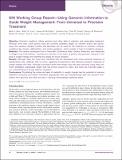| dc.contributor.author | Bray, Molly S | en_US |
| dc.contributor.author | Loos, Ruth JF | en_US |
| dc.contributor.author | McCaffery, Jeanne M | en_US |
| dc.contributor.author | Ling, Charlotte | en_US |
| dc.contributor.author | Franks, Paul W | en_US |
| dc.contributor.author | Weinstock, George M | en_US |
| dc.contributor.author | Snyder, Michael P | en_US |
| dc.contributor.author | Vassy, Jason L | en_US |
| dc.contributor.author | Agurs-Collins, Tanya | en_US |
| dc.date.accessioned | 2016-02-01T15:45:52Z | |
| dc.date.issued | 2015 | en_US |
| dc.identifier.citation | Bray, Molly S, Ruth JF Loos, Jeanne M McCaffery, Charlotte Ling, Paul W Franks, George M Weinstock, Michael P Snyder, Jason L Vassy, and Tanya Agurs-Collins. 2015. “NIH working group report—using genomic information to guide weight management: From universal to precision treatment.” Obesity (Silver Spring, Md.) 24 (1): 14-22. doi:10.1002/oby.21381. http://dx.doi.org/10.1002/oby.21381. | en |
| dc.identifier.issn | 1930-7381 | en |
| dc.identifier.uri | http://nrs.harvard.edu/urn-3:HUL.InstRepos:24983971 | |
| dc.description.abstract | Objective: Precision medicine utilizes genomic and other data to optimize and personalize treatment. Although more than 2,500 genetic tests are currently available, largely for extreme and/or rare phenotypes, the question remains whether this approach can be used for the treatment of common, complex conditions like obesity, inflammation, and insulin resistance, which underlie a host of metabolic diseases. Methods: This review, developed from a Trans-NIH Conference titled “Genes, Behaviors, and Response to Weight Loss Interventions,” provides an overview of the state of genetic and genomic research in the area of weight change and identifies key areas for future research. Results: Although many loci have been identified that are associated with cross-sectional measures of obesity/body size, relatively little is known regarding the genes/loci that influence dynamic measures of weight change over time. Although successful short-term weight loss has been achieved using many different strategies, sustainable weight loss has proven elusive for many, and there are important gaps in our understanding of energy balance regulation. Conclusions: Elucidating the molecular basis of variability in weight change has the potential to improve treatment outcomes and inform innovative approaches that can simultaneously take into account information from genomic and other sources in devising individualized treatment plans. | en |
| dc.language.iso | en_US | en |
| dc.publisher | John Wiley & Sons, Ltd | en |
| dc.relation.isversionof | doi:10.1002/oby.21381 | en |
| dc.relation.hasversion | http://www.ncbi.nlm.nih.gov/pmc/articles/PMC4689320/pdf/ | en |
| dash.license | LAA | en_US |
| dc.title | NIH working group report—using genomic information to guide weight management: From universal to precision treatment | en |
| dc.type | Journal Article | en_US |
| dc.description.version | Version of Record | en |
| dc.relation.journal | Obesity (Silver Spring, Md.) | en |
| dash.depositing.author | Vassy, Jason L | en_US |
| dc.date.available | 2016-02-01T15:45:52Z | |
| dc.identifier.doi | 10.1002/oby.21381 | * |
| dash.contributor.affiliated | Vassy, Jason | |


